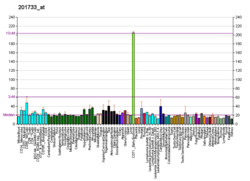H+/Cl− exchange transporter 3 is a protein that in humans is encoded by the CLCN3 gene.[5]
Interactions
[edit]CLCN3 has been shown to interact with PDZK1.[6]
See also
[edit]References
[edit]- ^ a b c GRCh38: Ensembl release 89: ENSG00000109572 – Ensembl, May 2017
- ^ a b c GRCm38: Ensembl release 89: ENSMUSG00000004319 – Ensembl, May 2017
- ^ "Human PubMed Reference:". National Center for Biotechnology Information, U.S. National Library of Medicine.
- ^ "Mouse PubMed Reference:". National Center for Biotechnology Information, U.S. National Library of Medicine.
- ^ "Entrez Gene: CLCN3 chloride channel 3".
- ^ Gentzsch M, Cui L, Mengos A, Chang XB, Chen JH, Riordan JR (Feb 2003). "The PDZ-binding chloride channel ClC-3B localizes to the Golgi and associates with cystic fibrosis transmembrane conductance regulator-interacting PDZ proteins". J. Biol. Chem. 278 (8): 6440–9. doi:10.1074/jbc.M211050200. PMID 12471024.
Further reading
[edit]- Borsani G, Rugarli EI, Taglialatela M, Wong C, Ballabio A (1995). "Characterization of a human and murine gene (CLCN3) sharing similarities to voltage-gated chloride channels and to a yeast integral membrane protein". Genomics. 27 (1): 131–41. doi:10.1006/geno.1995.1015. PMID 7665160.
- Taine L, Coupry I, Boisseau P, Saura R, Lacombe D, Arveiler B (1998). "Refined localisation of the voltage-gated chloride channel, CLCN3, to 4q33". Hum. Genet. 102 (2): 178–81. doi:10.1007/s004390050673. PMID 9521585. S2CID 22138203.
- Shepard AR, Rae JL (1998). "Ion transporters and receptors in cDNA libraries from lens and cornea epithelia". Curr. Eye Res. 17 (7): 708–19. doi:10.1080/02713689808951247. PMID 9678416.
- Loo MA, Jensen TJ, Cui L, Hou Y, Chang XB, Riordan JR (1998). "Perturbation of Hsp90 interaction with nascent CFTR prevents its maturation and accelerates its degradation by the proteasome". EMBO J. 17 (23): 6879–87. doi:10.1093/emboj/17.23.6879. PMC 1171036. PMID 9843494.
- Lamb FS, Clayton GH, Liu BX, Smith RL, Barna TJ, Schutte BC (1999). "Expression of CLCN voltage-gated chloride channel genes in human blood vessels". J. Mol. Cell. Cardiol. 31 (3): 657–66. doi:10.1006/jmcc.1998.0901. PMID 10198195.
- Hartley JL, Temple GF, Brasch MA (2000). "DNA cloning using in vitro site-specific recombination". Genome Res. 10 (11): 1788–95. doi:10.1101/gr.143000. PMC 310948. PMID 11076863.
- Wiemann S, Weil B, Wellenreuther R, Gassenhuber J, Glassl S, Ansorge W, Böcher M, Blöcker H, Bauersachs S, Blum H, Lauber J, Düsterhöft A, Beyer A, Köhrer K, Strack N, Mewes HW, Ottenwälder B, Obermaier B, Tampe J, Heubner D, Wambutt R, Korn B, Klein M, Poustka A (2001). "Toward a catalog of human genes and proteins: sequencing and analysis of 500 novel complete protein coding human cDNAs". Genome Res. 11 (3): 422–35. doi:10.1101/gr.GR1547R. PMC 311072. PMID 11230166.
- Huang P, Liu J, Di A, Robinson NC, Musch MW, Kaetzel MA, Nelson DJ (2001). "Regulation of human CLC-3 channels by multifunctional Ca2+/calmodulin-dependent protein kinase". J. Biol. Chem. 276 (23): 20093–100. doi:10.1074/jbc.M009376200. PMID 11274166.
- Lamb FS, Graeff RW, Clayton GH, Smith RL, Schutte BC, McCray PB (2001). "Ontogeny of CLCN3 chloride channel gene expression in human pulmonary epithelium". Am. J. Respir. Cell Mol. Biol. 24 (4): 376–81. doi:10.1165/ajrcmb.24.4.4114. PMID 11306429.
- Ogura T, Furukawa T, Toyozaki T, Yamada K, Zheng YJ, Katayama Y, Nakaya H, Inagaki N (2002). "ClC-3B, a novel ClC-3 splicing variant that interacts with EBP50 and facilitates expression of CFTR-regulated ORCC". FASEB J. 16 (8): 863–5. doi:10.1096/fj.01-0845fje. PMID 11967229. S2CID 33470444.
- Hermoso M, Satterwhite CM, Andrade YN, Hidalgo J, Wilson SM, Horowitz B, Hume JR (2002). "ClC-3 is a fundamental molecular component of volume-sensitive outwardly rectifying Cl- channels and volume regulation in HeLa cells and Xenopus laevis oocytes". J. Biol. Chem. 277 (42): 40066–74. doi:10.1074/jbc.M205132200. PMID 12183454.
- Gentzsch M, Cui L, Mengos A, Chang XB, Chen JH, Riordan JR (2003). "The PDZ-binding chloride channel ClC-3B localizes to the Golgi and associates with cystic fibrosis transmembrane conductance regulator-interacting PDZ proteins". J. Biol. Chem. 278 (8): 6440–9. doi:10.1074/jbc.M211050200. PMID 12471024.
- Jin NG, Kim JK, Yang DK, Cho SJ, Kim JM, Koh EJ, Jung HC, So I, Kim KW (2003). "Fundamental role of ClC-3 in volume-sensitive Cl- channel function and cell volume regulation in AGS cells". Am. J. Physiol. Gastrointest. Liver Physiol. 285 (5): G938-48. doi:10.1152/ajpgi.00470.2002. PMID 12842831. S2CID 326508.
- Olsen ML, Schade S, Lyons SA, Amaral MD, Sontheimer H (2003). "Expression of voltage-gated chloride channels in human glioma cells". J. Neurosci. 23 (13): 5572–82. doi:10.1523/JNEUROSCI.23-13-05572.2003. PMC 6741216. PMID 12843258.
- Salazar G, Love R, Styers ML, Werner E, Peden A, Rodriguez S, Gearing M, Wainer BH, Faundez V (2004). "AP-3-dependent mechanisms control the targeting of a chloride channel (ClC-3) in neuronal and non-neuronal cells". J. Biol. Chem. 279 (24): 25430–9. doi:10.1074/jbc.M402331200. PMID 15073168.
- Wiemann S, Arlt D, Huber W, Wellenreuther R, Schleeger S, Mehrle A, Bechtel S, Sauermann M, Korf U, Pepperkok R, Sültmann H, Poustka A (2004). "From ORFeome to biology: a functional genomics pipeline". Genome Res. 14 (10B): 2136–44. doi:10.1101/gr.2576704. PMC 528930. PMID 15489336.
- Zhou JG, Ren JL, Qiu QY, He H, Guan YY (2005). "Regulation of intracellular Cl- concentration through volume-regulated ClC-3 chloride channels in A10 vascular smooth muscle cells". J. Biol. Chem. 280 (8): 7301–8. doi:10.1074/jbc.M412813200. PMID 15596438.
- Yeung CH, Barfield JP, Cooper TG (2005). "Chloride channels in physiological volume regulation of human spermatozoa". Biol. Reprod. 73 (5): 1057–63. doi:10.1095/biolreprod.105.044123. PMID 16033995.
- Mehrle A, Rosenfelder H, Schupp I, del Val C, Arlt D, Hahne F, Bechtel S, Simpson J, Hofmann O, Hide W, Glatting KH, Huber W, Pepperkok R, Poustka A, Wiemann S (2006). "The LIFEdb database in 2006". Nucleic Acids Res. 34 (Database issue): D415-8. doi:10.1093/nar/gkj139. PMC 1347501. PMID 16381901.
External links
[edit]- CLCN3+protein,+human at the U.S. National Library of Medicine Medical Subject Headings (MeSH)
- Human CLCN3 genome location and CLCN3 gene details page in the UCSC Genome Browser.
This article incorporates text from the United States National Library of Medicine, which is in the public domain.






